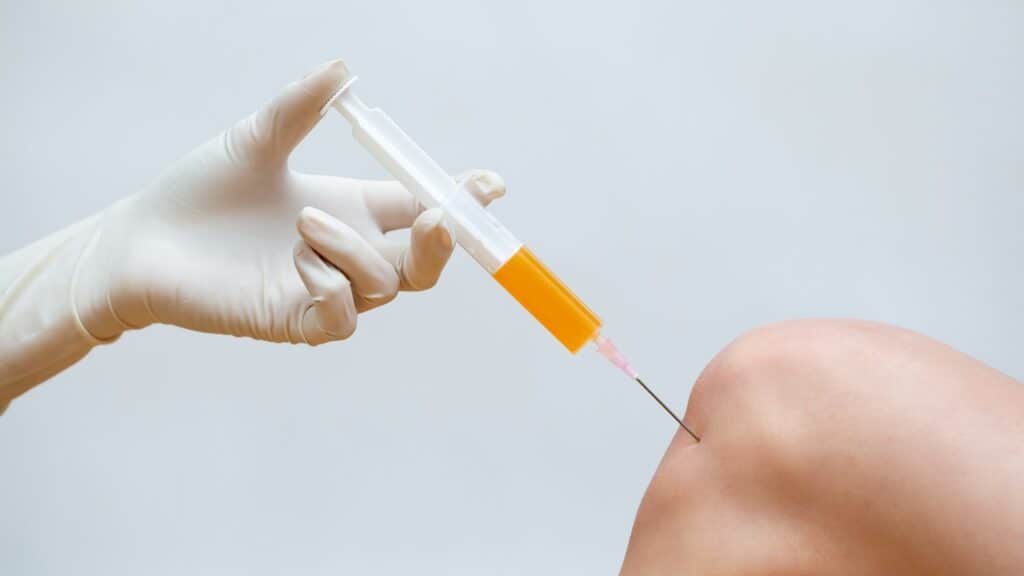Regenerative injection therapy is revolutionizing the approach to pain management, offering hope to millions suffering from chronic discomfort. This innovative treatment utilizes the body’s own healing mechanisms to target and alleviate pain at its source, providing a natural alternative to traditional methods. In this article, we delve into the fascinating world of regenerative injection therapy, exploring its mechanisms of action and the profound impact it can have on individuals battling various forms of pain.
Understanding Regenerative Injection Therapy: An Overview
Regenerative injection therapy, often referred to as regenerative medicine, represents a paradigm shift in pain management. This cutting-edge approach utilizes the body’s own natural healing mechanisms to address chronic pain and injury. By leveraging substances like platelet-rich plasma (PRP) and stem cells, regenerative injection therapy aims to stimulate tissue repair and regeneration. Understanding the fundamentals of this therapy is crucial for patients seeking alternatives to conventional treatments.
The Science Behind Regenerative Injection Therapy
Regenerative injection therapy operates on the principles of regenerative medicine, which focuses on repairing, replacing, or regenerating damaged tissues to restore normal function. At its core, this therapy harnesses the regenerative potential of biological substances such as platelet-rich plasma (PRP) and stem cells.
PRP contains concentrated growth factors that promote tissue repair, while stem cells possess the ability to differentiate into various cell types, aiding in tissue regeneration. Understanding the underlying science elucidates how regenerative injection therapy offers a promising avenue for pain relief and healing.
Harnessing the Body’s Healing Power: How It Works
Regenerative injection therapy taps into the body’s innate ability to heal itself. By delivering concentrated forms of healing factors directly to the site of injury or pain, this therapy accelerates the body’s natural repair processes.
Whether it’s through platelet-rich plasma (PRP) injections or stem cell therapy, regenerative techniques stimulate cellular regeneration, reduce inflammation, and promote tissue healing. This approach not only addresses symptoms but also targets the underlying cause of pain, offering patients a holistic and long-lasting solution to their discomfort.
Types of Pain Treatable with Regenerative Injection Therapy
Regenerative injection therapy holds promise for treating various types of pain, including musculoskeletal conditions, joint injuries, and soft tissue injuries. Whether it’s chronic back pain, osteoarthritis, tendonitis, or ligament injuries, regenerative techniques offer a non-surgical option for pain relief and tissue repair. By targeting the source of pain and promoting healing from within, regenerative injection therapy can improve mobility, reduce pain, and enhance overall quality of life for individuals suffering from a range of painful conditions.
Comparing Regenerative Injection Therapy to Traditional Methods
In contrast to traditional pain management approaches that often rely on medications, corticosteroid injections, or surgery, regenerative injection therapy offers a more natural and holistic alternative. While conventional methods may provide temporary relief by masking symptoms, regenerative techniques aim to address the underlying cause of pain and promote long-term healing.
By harnessing the body’s own healing mechanisms, regenerative therapy offers the potential for sustained pain relief, reduced reliance on medications, and improved functional outcomes for patients with chronic pain and musculoskeletal conditions.
Conditions Benefiting from Regenerative Injection Therapy
Regenerative injection therapy has shown promise in treating a wide range of conditions, including osteoarthritis, tendon injuries, ligament sprains, and chronic joint pain. Whether it’s degenerative joint disease, rotator cuff tears, tennis elbow, or plantar fasciitis, regenerative techniques offer a non-surgical option for pain relief and tissue repair.
By promoting the regeneration of damaged tissues and reducing inflammation, regenerative therapy can improve joint function, enhance mobility, and alleviate pain, enabling patients to return to their daily activities with greater comfort and ease.
Exploring the Role of Stem Cells in Pain Management
Stem cells play a crucial role in regenerative injection therapy, offering the potential to regenerate damaged tissues and modulate the inflammatory response. Mesenchymal stem cells, derived from sources such as bone marrow or adipose tissue, possess the ability to differentiate into various cell types, including bone, cartilage, and muscle cells.
When injected into injured tissues, these stem cells promote tissue repair, reduce inflammation, and modulate pain signals, offering a regenerative approach to pain management. Understanding the unique properties of stem cells elucidates their therapeutic potential in treating a variety of musculoskeletal conditions and injuries.
Platelet-Rich Plasma (PRP): A Key Component of Regenerative Therapy
Platelet-rich plasma (PRP) is a concentrated form of blood plasma that contains a high concentration of platelets, growth factors, and other bioactive proteins. In regenerative injection therapy, PRP is often used to stimulate tissue repair, reduce inflammation, and promote healing.
By delivering a potent cocktail of growth factors directly to the site of injury or pain, PRP injections can accelerate the body’s natural healing processes, leading to improved tissue regeneration and pain relief. Understanding the role of PRP in regenerative therapy sheds light on its potential applications in treating a variety of musculoskeletal conditions and injuries.
The Procedure: What to Expect During Regenerative Injection Therapy
Regenerative injection therapy typically involves a series of injections performed under ultrasound or fluoroscopic guidance to ensure precise placement of the therapeutic agents. Depending on the specific condition being treated, injections may contain platelet-rich plasma (PRP), stem cells, or other regenerative substances.
The procedure is minimally invasive and performed on an outpatient basis, with minimal discomfort and downtime. Patients can expect to return to their normal activities shortly after the procedure, with the full effects of regenerative therapy typically manifesting over the course of several weeks to months.
Safety and Effectiveness of Regenerative Injection Therapy
Regenerative injection therapy is generally considered safe and well-tolerated, with minimal risk of adverse effects. Since the therapeutic agents used are derived from the patient’s own body, there is minimal risk of allergic reactions or rejection. Moreover, regenerative techniques offer a natural alternative to medications, corticosteroid injections, and surgery, reducing the risk of complications associated with more invasive procedures.
While individual responses to regenerative therapy may vary, numerous studies have demonstrated its effectiveness in promoting tissue repair, reducing pain, and improving function in patients with various musculoskeletal conditions and injuries.
Personalized Treatment Plans: Tailoring Therapy to Individual Needs
One of the key advantages of regenerative injection therapy is its ability to be customized to meet the unique needs of each patient. By taking into account factors such as the severity of the condition, the patient’s overall health, and their treatment goals, healthcare providers can develop personalized treatment plans tailored to optimize outcomes.
Whether it’s adjusting the concentration of platelet-rich plasma (PRP), selecting the most appropriate source of stem cells, or combining regenerative techniques with physical therapy, personalized treatment plans ensure that patients receive the most effective and comprehensive care for their specific condition.
Combining Regenerative Therapy with Physical Rehabilitation
While regenerative injection therapy can promote tissue repair and pain relief, incorporating physical rehabilitation can further enhance outcomes and facilitate long-term recovery. Physical therapy exercises and rehabilitation techniques can improve strength, flexibility, and joint stability, helping patients regain function and mobility more quickly.
By combining regenerative therapy with targeted exercises and rehabilitation protocols, patients can maximize the benefits of treatment, reduce the risk of recurrent injury, and achieve optimal functional outcomes. Understanding the synergistic effects of regenerative therapy and physical rehabilitation underscores the importance of a comprehensive approach to pain management and recovery.
Potential Side Effects and Risks of Regenerative Injection Therapy
Although regenerative injection therapy is generally safe and well-tolerated, there are potential risks and side effects associated with the procedure. These may include temporary pain or discomfort at the injection site, bruising, swelling, or infection. In rare cases, there may be allergic reactions to the injected substances or inadvertent damage to surrounding tissues or structures. It’s essential for patients to discuss any concerns or medical history with their healthcare provider before undergoing regenerative therapy and to follow post-procedure instructions carefully to minimize the risk of complications.
Research and Future Directions in Regenerative Pain Management
The field of regenerative pain management is continually evolving, with ongoing research exploring new techniques, applications, and advancements in the field. From investigating novel sources of stem cells to optimizing delivery methods and enhancing therapeutic outcomes, researchers are working to expand the potential of regenerative therapy in treating a wide range of musculoskeletal conditions and injuries.
Additionally, clinical trials are underway to evaluate the safety and efficacy of regenerative techniques in various patient populations, paving the way for future innovations and advancements in regenerative pain management.
Finding a Qualified Provider: Tips for Accessing Regenerative Injection Therapy
When considering regenerative injection therapy, it’s essential to seek treatment from a qualified and experienced healthcare provider who specializes in regenerative medicine. Patients should research providers thoroughly, ensuring they have the necessary expertise and credentials to perform regenerative procedures safely and effectively.
Additionally, patients should inquire about the provider’s experience, success rates, and patient testimonials to gauge the quality of care they can expect. By choosing a reputable and qualified provider, patients can feel confident in their decision to pursue regenerative therapy and maximize their chances of achieving successful outcomes.
Exploring the transformative effects of regenerative injection therapy on pain management reveals a promising avenue for those seeking relief from chronic discomfort. If you’re ready to experience the benefits of regenerative therapy firsthand, contact ActiveMed Integrative Health Center today.
Our dedicated team in Encinitas is committed to offering exceptional natural medical services tailored to your health and wellness goals. Take the first step towards a pain-free life by calling 858-673-4400 or emailing info@activemedhealth.com to schedule your consultation. Let us help you reclaim your vitality and live life to the fullest with regenerative injection therapy.




